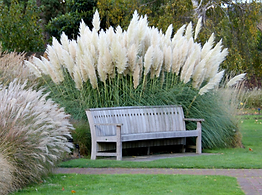Ornamental grasses have grown in popularity in the last decade. They bring beauty and movement to a landscape. They are relatively easy to grow and add a certain mystique to the garden. Grasses come in a variety of sizes and colors and are available as perennials and annuals (Flower Classifications).
Ornamental grasses grow quickly, are very hardy, and resistant to deer and diseases. Questions that always arise in the fall regarding grasses are; how do you care for ornamental grasses; and should you cut them in the spring or fall? Read on for answers.
(Some of the links within this post are affiliate links on which I receive a small compensation from the sale of certain items at no extra cost to you.)
(As an Amazon Associate I earn from qualifying purchases.)
How to Care for Ornamental Grasses
When to Cut Them, Spring or Fall?
Since grasses are hardy and their root ball is between 12 and 18 inches deep, it really doesn’t matter in which season you cut them. They can be trimmed in late fall, early to mid-spring or even in the dead of winter. It really depends on your personal preference. Here are a few things to consider when deciding when to trim your grasses.
Reasons to NOT CUT them in the Fall:
Many grasses flower and produce plumes in the fall. Why would you cut them back in autumn and not enjoy their flowing beauty? Among the reasons for allowing them to sway through the fall and winter are:
- they add beauty, movement, and interest to the otherwise barren landscape of winter
- the seed heads will provide food for birds and other animals in the winter
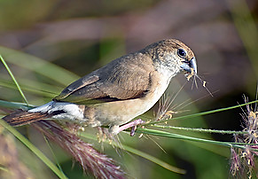
- they provide shelter for small animals
- grasses look beautiful when weighed down with sleet or snow
- the grasses make a unique sound when the they rustle through a breeze
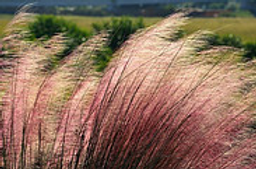
Reasons to CUT them in the Fall:
Honestly, the only reason I see to cut them in the fall is to prevent the fallen leaves of the grasses from blowing and spreading throughout your yard. The tall plumes will eventually bend and break off. They will then scatter in the wind. It will make for an easier clean-up in the spring if you cut them in the fall.
WARNING
If you live in an area prone to wildfires, use caution when leaving grasses throughout the winter for their ornamental appeal. It is recommended that you do not wait to cut the leaves until the spring. Instead, cut them at the end of the growing season. Some areas are strongly cautioning people against planting ornamental grasses. They are very flammable and will aid in the spread of wildfires. If you do plant ornamental grasses, plant them away from your home and other structures on your property.
How to Cut Ornamental Grasses
You can either cut the grasses down to the ground, or 6 to 12 inches above the ground.
If you have a cool season grass (one that primarily grows in early spring when the temperatures are cooler and stops growing in the summer), then cut the grass back by two-thirds leaving one-third above the ground. These varieties include Autumn Moor, Tufted Hair, Fescue, and Blue Oat Gras
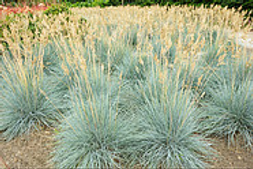
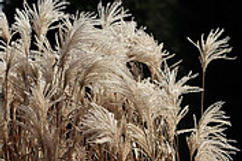
The other variety is warm season grasses. This variety begins growing in mid to late spring and early summer when the temperatures are warmer. They continue to grow profusely and bloom in the heat of the summer. These grasses should be cut back to the ground and include varieties such as Erianthus, Miscanthus, and Cortaderia.
How to Cut Ornament Grasses
- Here is an easy way to cut the grasses without too much waste.
- put on garden gloves; the blades can be quite sharp
- bundle them in manageable sizes
- wrap them with wide, sticky, biodegradable paper tape above where you will be cutting them; an alternative is to use reusable bungie straps to gather the stalks
- you may have to tape them two or three times up the stalk depending on their height
- use hand-held hedge clippers, pruning shears or an electric hedge trimmer to cut them to the height mentioned above Purchase Sakor Cordless hedge trimmer from Amazon
- keep them bundled and cut them into lengths of 6 inches or so and dispose of them in your compost pile or a municipal lawn waste site. If composting, add some nitrogen fertilizer to aid the breakdown or some green, wet material.
Click here for more information on garden tools and which to have on hand when beginning a garden.

How to Fertilize Ornamental Grasses
Most grasses are very hardy. Once you plant them they will not need much care. However, it is good to give them a jumpstart when you initially plant the grass and at subsequent growing stages. When the plant begins to grow in the spring, apply fertilizer. It will last through the summer.
Purchase a slow release fertilizer such as Osmocote and work the proper amount into the top 2 to 3 inches of soil next to the grass ball. Read the directions on the container to determine the correct amount. Then water it into the soil.
Purchase Osmocote Here.
I rarely fertilize my grasses and they grow beautifully. However, if you choose to fertilize, apply the fertilizer only one time per year, or take your chances and not apply it at all!
Fall is a great time to purchase NEW ornamental grasses. When purchasing in the fall, the plant will come in a compact root ball ready for planting. You will be rewarded with much bigger and beautiful grasses in the spring.
Dividing Ornamental Grasses
As I noted above, ornamental grasses are very hardy and do not require much care. However, after 3 or 4 seasons the grasses will die in the center of the bundle. This is because they produce more growth from the outer edges of the bundle and as the plant ages it dies off from the center.
You DO NOT want to divide existing ornamental grasses in the fall. The roots will not have time to establish themselves and be protected from a harsh winter. It is best to divide grasses in the late winter or early spring before new growth has begun.
As I noted above, you can purchase and plant new self contained plants from a gardening center in the fall.
Purchase Grasses From Nature Hills Nursery
How to Divide and Plant Grasses:
- If you have not cut back your grasses, cut them back to 2 to 3 inches from the soil line
- With a spade shovel dig around the entire circumference of the plant.
- Dig down to the depth of the shovel head.
- If the grass is too wide, take the spade shovel and dig straight down through the root ball and divide it into smaller sections.
- After digging around each section, place the shovel under the root of the plant and lift it out of the ground.
- Once the grass is out of the ground, remove the dead center section and discard in a compost pile.
- Divide the chunks of root into 5 inch wide sections to create new plants. This is easier if you turn the plant over and with a sharp shovel or axe, cut through the roots to create the sections.
- Dig a hole twice the size of the new root ball, mix in a little compost to the soil, transplant the ball, keeping it slightly below the soil level, then water thoroughly.
Now you can enjoy your new healthy grasses. If you have excess root balls, share them with neighbors and friends.
Easy-Peasy!
Once you determine the type of grass you have, warm or cool season variety, it is quite easy to trim your grasses. If it is a cool season grass, cut it down by two thirds of the plant size. If the grass is a warm season variety, cut it back to the soil level.
Of course, you’ll have to decide whether or not you want them to flourish in the winds of the winter and feed our fine feathered friends!
After three or 4 years of growth and the centers begin to die out, divide your grasses to add more beauty to your yard. You will be amazed at how much better your garden looks once the ornamental grasses are thriving, adding motion, color, and grace to your perfect oasis.
For more information on landscaping with ornamental grasses, click here.
I hope you enjoyed this post. Please leave a comment below and share the post with friends and family. Browse my website for more tips for beginners.
Happy Gardening!
bestgardeningforbeginners@gmail.com

